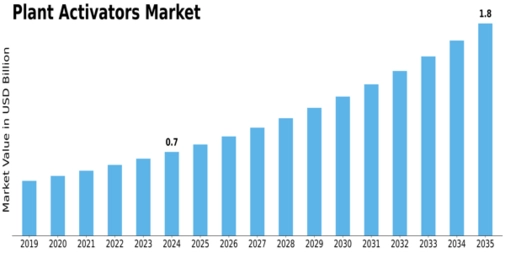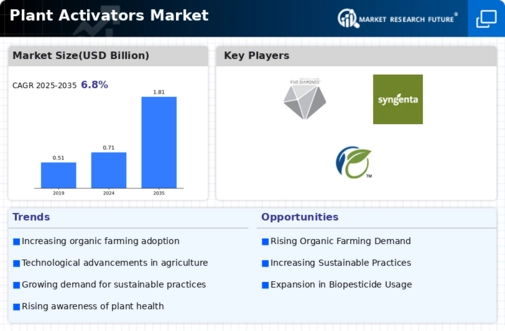-
1 EXECUTIVE SUMMARY
-
Market Attractiveness Analysis
- Global Plant Activators Market, by Source
- Global Plant Activators Market, by Form
- Global Plant Activators Market, by Mode of Application
- Global Plant Activators Market, by Crop Type
- Global Plant Activators Market, by Region
-
MARKET INTRODUCTION
-
Definition
-
Scope of the Study
-
Market Structure
-
Key Buying Criteria
-
Macro Factor Indicator Analysis
-
RESEARCH METHODOLOGY
-
Research Process
-
Primary Research
-
Secondary Research
-
Market Size Estimation
-
Forecast Model
-
List of Assumptions
-
MARKET DYNAMICS
-
Introduction
-
Drivers
-
Restraints
-
Opportunities
-
Challenges
-
MARKET FACTOR ANALYSIS
-
Value Chain Analysis
-
Supply Chain Analysis
-
Porter’s Five Forces Model
- Bargaining Power of Suppliers
- Bargaining Power of Buyers
- Threat of New Entrants
- Threat of Substitutes
- Intensity of Rivalry
-
GLOBAL PLANT ACTIVATORS MARKET, BY SOURCE
-
Introduction
-
Biological
- Biological: Market Estimates & Forecast, by Region/Country, 2022-2030
-
Chemical
- Chemical: Market Estimates & Forecast, by Region/Country, 2022-2030
-
GLOBAL PLANT ACTIVATORS MARKET, BY FORM
-
Introduction
-
Powder
- Powder: Market Estimates & Forecast, by Region/Country, 2022-2030
-
Granules
- Granules: Market Estimates & Forecast, by Region/Country, 2022-2030
-
Liquid
- Liquid: Market Estimates & Forecast, by Region/Country, 2022-2030
-
GLOBAL PLANT ACTIVATORS MARKET, BY MODE OF APPLICATION
-
Introduction
-
Foliar
- Foliar: Market Estimates & Forecast, by Region/Country, 2022-2030
-
Soil Treatment
- Soil Treatment: Market Estimates & Forecast, by Region/Country, 2022-2030
-
Others
- Others: Market Estimates & Forecast, by Region/Country, 2022-2030
-
GLOBAL PLANT ACTIVATORS MARKET, BY CROP TYPE
-
Introduction
-
Oilseeds & Pulses
- Oilseeds & Pulses: Market Estimates & Forecast, by Region/Country, 2022-2030
-
Cereals & Grains
- Cereals & Grains: Market Estimates & Forecast, by Region/Country, 2022-2030
-
Fruits & Vegetables
- Fruits & Vegetables: Market Estimates & Forecast, by Region/Country, 2022-2030
-
Others
- Others: Market Estimates & Forecast, by Region/Country, 2022-2030
-
GLOBAL PLANT ACTIVATORS MARKET, BY REGION
-
Introduction
-
North America
- Market Estimates & Forecast, by Source, 2022-2030
- Market Estimates & Forecast, by Form, 2022-2030
- Market Estimates & Forecast, by Mode of Application, 2022-2030
- Market Estimates & Forecast, by Crop Type, 2022-2030
- Market Estimates & Forecast, by Country, 2022-2030
- US
- Canada
- Mexico
-
Europe
- Market Estimates & Forecast, by Source, 2022-2030
- Market Estimates & Forecast, by Form, 2022-2030
- Market Estimates & Forecast, by Mode of Application, 2022-2030
- Market Estimates & Forecast, by Crop Type, 2022-2030
- Market Estimates & Forecast, by Country, 2022-2030
- Germany
- UK
- France
- Spain
- Italy
- Rest of Europe
-
Asia-Pacific
- Market Estimates & Forecast, by Source, 2022-2030
- Market Estimates & Forecast, by Form, 2022-2030
- Market Estimates & Forecast, by Mode of Application, 2022-2030
- Market Estimates & Forecast, by Crop Type, 2022-2030
- Market Estimates & Forecast, by Country, 2022-2030
- China
- Japan
- India
- Australia & New Zealand
- Rest of Asia-Pacific
-
Rest of the World
- Market Estimates & Forecast, by Source, 2022-2030
- Market Estimates & Forecast, by Form, 2022-2030
- Market Estimates & Forecast, by Mode of Application, 2022-2030
- Market Estimates & Forecast, by Crop Type, 2022-2030
- Market Estimates & Forecast, by Region, 2022-2030
- South America
- Middle East
- Africa
-
COMPETITIVE LANDSCAPE
-
Introduction
-
Competitive Benchmarking
-
Development Share Analysis
-
Key Developments & Growth Strategies
-
COMPANY PROFILES
-
Isagro
- Company Overview
- Financial Overview
- Products Offered
- Key Developments
- SWOT Analysis
- Key Strategies
-
NutriAg Inc.
- Company Overview
- Financial Overview
- Products Offered
- Key Developments
- SWOT Analysis
- Key Strategies
-
Syngenta
- Company Overview
- Financial Overview
- Products Offered
- Key Developments
- SWOT Analysis
- Key Strategies
-
Plant Health Care
- Company Overview
- Financial Overview
- Products Offered
- Key Developments
- SWOT Analysis
- Key Strategies
-
BASF SE
- Company Overview
- Financial Overview
- Products Offered
- Key Developments
- SWOT Analysis
- Key Strategies
-
Gowan Company
- Company Overview
- Financial Overview
- Products Offered
- Key Developments
- SWOT Analysis
- Key Strategies
-
Eagle Plant Protect Private Limited
- Company Overview
- Financial Overview
- Products Offered
- Key Developments
- SWOT Analysis
- Key Strategies
-
Nihon Nohyaku Co. Ltd
- Company Overview
- Financial Overview
- Products Offered
- Key Developments
- SWOT Analysis
- Key Strategies
-
Meiji Holdings Co. Ltd
- Company Overview
- Financial Overview
- Products Offered
- Key Developments
- SWOT Analysis
- Key Strategies
-
Certis USA LLC
- Company Overview
- Financial Overview
- Products Offered
- Key Developments
- SWOT Analysis
- Key Strategies
-
Arysta LifeScience Corporation
- Company Overview
- Financial Overview
- Products Offered
- Key Developments
- SWOT Analysis
- Key Strategies
-
Futureco Bioscience SA
- Company Overview
- Financial Overview
- Products Offered
- Key Developments
- SWOT Analysis
- Key Strategies
-
APPENDIX
-
General Sources & References
-
List of Abbreviation
-
-
LIST OF TABLES
-
Global Plant Activators, by Region, 2022-2030 (USD Million)
-
Global Plant Activators, by Source, 2022-2030 (USD Million)
-
Global Plant Activators, by Form,2022-2030 (USD Million)
-
Global Plant Activators, by Mode of Application, 2022-2030 (USD Million)
-
Global Plant Activators, by Crop Type, 2022-2030 (USD Million)
-
North America: Plant Activators, by Country, 2022-2030 (USD Million)
-
North America: Plant Activators, by Source, 2022-2030 (USD Million)
-
North America: Plant Activators, by Form,2022-2030 (USD Million)
-
North America: Plant Activators, by Mode of Application, 2022-2030 (USD Million)
-
North America: Plant Activators, by Crop Type, 2022-2030 (USD Million)
-
US: Plant Activators, by Source, 2022-2030 (USD Million)
-
US: Plant Activators, by Form,2022-2030 (USD Million)
-
US: Plant Activators, by Mode of Application, 2022-2030 (USD Million)
-
US: Plant Activators, by Crop Type, 2022-2030 (USD Million)
-
Canada: Plant Activators, by Source, 2022-2030 (USD Million)
-
Canada: Plant Activators, by Form,2022-2030 (USD Million)
-
Canada: Plant Activators, by Mode of Application, 2022-2030 (USD Million)
-
Canada: Plant Activators, by Crop Type, 2022-2030 (USD Million)
-
Mexico: Plant Activators, by Source, 2022-2030 (USD Million)
-
Mexico: Plant Activators, by Form,2022-2030 (USD Million)
-
Mexico: Plant Activators, by Mode of Application, 2022-2030 (USD Million)
-
Mexico: Plant Activators, by Crop Type, 2022-2030 (USD Million)
-
Europe: Plant Activators, by Country, 2022-2030 (USD Million)
-
Europe: Plant Activators, by Source, 2022-2030 (USD Million)
-
Europe: Plant Activators, by Form,2022-2030 (USD Million)
-
Europe: Plant Activators, by Mode of Application, 2022-2030 (USD Million)
-
Europe: Plant Activators, by Crop Type, 2022-2030 (USD Million)
-
Germany: Plant Activators, by Source, 2022-2030 (USD Million)
-
Germany: Plant Activators, by Form,2022-2030 (USD Million)
-
Germany: Plant Activators, by Mode of Application, 2022-2030 (USD Million)
-
Germany: Plant Activators, by Crop Type, 2022-2030 (USD Million)
-
France: Plant Activators, by Source, 2022-2030 (USD Million)
-
France: Plant Activators, by Form,2022-2030 (USD Million)
-
France: Plant Activators, by Mode of Application, 2022-2030 (USD Million)
-
France: Plant Activators, by Crop Type, 2022-2030 (USD Million)
-
Italy: Plant Activators, by Source, 2022-2030 (USD Million)
-
Italy: Plant Activators, by Form,2022-2030 (USD Million)
-
Italy: Plant Activators, by Mode of Application, 2022-2030 (USD Million)
-
Italy: Plant Activators, by Crop Type, 2022-2030 (USD Million)
-
Spain: Plant Activators, by Source, 2022-2030 (USD Million)
-
Spain: Plant Activators, by Form,2022-2030 (USD Million)
-
Spain: Plant Activators, by Mode of Application, 2022-2030 (USD Million)
-
Spain: Plant Activators, by Crop Type, 2022-2030 (USD Million)
-
UK: Plant Activators, by Source, 2022-2030 (USD Million)
-
UK: Plant Activators, by Form,2022-2030 (USD Million)
-
UK: Plant Activators, by Mode of Application, 2022-2030 (USD Million)
-
UK: Plant Activators, by Crop Type, 2022-2030 (USD Million)
-
Rest of Europe: Plant Activators, by Source, 2022-2030 (USD Million)
-
Rest of Europe: Plant Activators, by Form,2022-2030 (USD Million)
-
Rest of Europe: Plant Activators, by Mode of Application, 2022-2030 (USD Million)
-
Rest of Europe: Plant Activators, by Crop Type, 2022-2030 (USD Million)
-
Asia-Pacific: Plant Activators, by Country, 2022-2030 (USD Million)
-
Asia-Pacific: Plant Activators, by Source, 2022-2030 (USD Million)
-
Asia-Pacific: Plant Activators, by Form,2022-2030 (USD Million)
-
Asia-Pacific: Plant Activators, by Mode of Application, 2022-2030 (USD Million)
-
Asia-Pacific: Plant Activators, by Crop Type, 2022-2030 (USD Million)
-
China: Plant Activators, by Source, 2022-2030 (USD Million)
-
China: Plant Activators, by Form,2022-2030 (USD Million)
-
China: Plant Activators, by Mode of Application, 2022-2030 (USD Million)
-
China: Plant Activators, by Crop Type, 2022-2030 (USD Million)
-
India: Plant Activators, by Source, 2022-2030 (USD Million)
-
India: Plant Activators, by Form,2022-2030 (USD Million)
-
India: Plant Activators, by Mode of Application, 2022-2030 (USD Million)
-
India: Plant Activators, by Crop Type, 2022-2030 (USD Million)
-
Japan: Plant Activators, by Source, 2022-2030 (USD Million)
-
Japan: Plant Activators, by Form,2022-2030 (USD Million)
-
Japan: Plant Activators, by Mode of Application, 2022-2030 (USD Million)
-
Japan: Plant Activators, by Crop Type, 2022-2030 (USD Million)
-
Australia & New Zealand: Plant Activators, by Source, 2022-2030 (USD Million)
-
Australia & New Zealand: Plant Activators, by Form,2022-2030 (USD Million)
-
Australia & New Zealand: Plant Activators, by Mode of Application, 2022-2030 (USD Million)
-
Australia & New Zealand: Plant Activators, by Crop Type, 2022-2030 (USD Million)
-
Rest of Asia-Pacific: Plant Activators, by Source, 2022-2030 (USD Million)
-
Rest of Asia-Pacific: Plant Activators, by Form,2022-2030 (USD Million)
-
Rest of Asia-Pacific: Plant Activators, by Mode of Application, 2022-2030 (USD Million)
-
Rest of Asia-Pacific: Plant Activators, by Crop Type, 2022-2030 (USD Million)
-
Rest of the World (RoW): Plant Activators, by Country, 2022-2030 (USD Million)
-
Rest of the World (RoW): Plant Activators, by Source, 2022-2030 (USD Million)
-
Rest of the World (RoW): Plant Activators, by Form,2022-2030 (USD Million)
-
Rest of the World (RoW): Plant Activators, by Mode of Application, 2022-2030 (USD Million)
-
Rest of the World (RoW): Plant Activators, by Crop Type, 2022-2030 (USD Million)
-
South America: Plant Activators, by Source, 2022-2030 (USD Million)
-
South America: Plant Activators, by Form,2022-2030 (USD Million)
-
South America: Plant Activators, by Mode of Application, 2022-2030 (USD Million)
-
South America: Plant Activators, by Crop Type, 2022-2030 (USD Million)
-
Middle East: Plant Activators, by Source, 2022-2030 (USD Million)
-
Middle East: Plant Activators, by Form, 2022-2030 (USD Million)
-
Middle East: Plant Activators, by Mode of Application, 2022-2030 (USD Million)
-
Middle East: Plant Activators, by Crop Type, 2022-2030 (USD Million)
-
Africa: Plant Activators, by Source, 2022-2030 (USD Million)
-
Africa: Plant Activators, by Form,2022-2030 (USD Million)
-
Africa: Plant Activators, by Mode of Application, 2022-2030 (USD Million)
-
Africa: Plant Activators, by Crop Type, 2022-2030 (USD Million)
-
-
LIST OF FIGURES
-
Global Plant Activators Market Segmentation
-
Forecast Research Methodology
-
Five Forces Analysis of the Global Plant Activators Market
-
Value Chain of the Global Plant Activators Market
-
Share of the Global Plant Activators Market in 2020, by Country (%)
-
Global Plant Activators Market, by Region, 2022-2030,
-
Global Plant Activators Market Size, by Source, 2020
-
Share of the Global Plant Activators Market, by Source, 2022-2030 (%)
-
Global Plant Activators Market Size, by Form, 2020
-
Share of the Global Plant Activators Market, by Form, 2022-2030 (%)
-
Global Plant Activators Market Size, by Mode of Application, 2020
-
Share of the Global Plant Activators Market, by Mode of Application, 2022-2030 (%)
-
Global Plant Activators Market Size, by Crop Type, 2020
-
Share of the Global Plant Activators Market, by Crop Type, 2022-2030 (%)















Leave a Comment